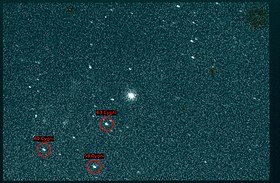
V1974 Cygni or Nova Cygni 1992 was a nova, visible to the naked eye, in the constellation Cygnus. It was discovered visually with 10×50 binoculars on February 19, 1992, by Peter Collins, an amateur astronomer living in Boulder, Colorado. At that time he first noticed it, it had an apparent magnitude of 7.2. Nine hours later he saw it again, and it had brightened by a full magnitude. For this discovery Collins was awarded the AAVSO Nova Award in 1993. The nova reached magnitude 4.4 at 22:00 UT on 22 February 1992. Images from the Palomar Sky Survey taken before the nova event showed identified a possible precursor which had photographic magnitudes of 18 and 17, but the identification of the precursor is not firm.

V476 Cygni or Nova Cygni 1920 was a nova which occurred in the constellation Cygnus in 1920. It was discovered by William Frederick Denning, an English amateur astronomer, at 09:30 GMT on 20 August 1920, at which time it had a magnitude of 3.7. It reached a peak brightness of magnitude 1.7 on 23 August 1920. Its quiescent brightness is magnitude 17.09.

V1668 Cygni was a nova that appeared in the northern constellation of Cygnus, situated a couple of degrees to the southeast of the star Rho Cygni. It was discovered by Canadian variable star observer Warren Morrison on September 10, 1978, and reached a peak brightness of around 6.22 apparent magnitude on September 12. The luminosity of the source at this time was about 100,000 times the brightness of the Sun, and likely remained at that level for several months. The expansion velocity of the nova shell was deduced through spectroscopy to be 1,300 km/s.
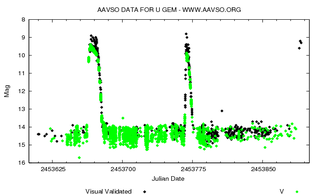
U Geminorum, in the constellation Gemini, is an archetypal example of a dwarf nova. The binary star system consists of a white dwarf closely orbiting a red dwarf. Every few months it undergoes an outburst that greatly increases its brightness. The dwarf nova class of variable stars are often referred to as U Geminorum variables after this star.

32 Cygni is the Flamsteed designation for a binary star system in the Cygnus constellation. It is a 4th magnitude star, which can be seen with the naked eye under suitably dark skies. Parallax measurements give an estimated distance of 1,100 light-years (320 parsecs) from the Earth. However, Schröder et al. (2007) suggest the actual value, after correcting for Malmquist bias, may be closer to 1,174 light-years (360 parsecs). Although it is a spectrsocopic binary with components that cannot be separated visually, it has two entries in the Henry Draper Catalogue, with identical magnitudes and positions, but showing the spectral types of the two components.

SS Cygni is a variable star in the northern constellation Cygnus. It was discovered in 1896 by Louisa D. Wells, a computer working under Edward Pickering at Harvard College Observatory. It is the prototype of the subclass of dwarf novae that show only normal eruptions. It typically rises from 12th magnitude to 8th magnitude for 1–2 days every 7 or 8 weeks. The northerly declination of SS Cygni makes the star almost circumpolar from European and North American latitudes, allowing a large proportion of the world's amateur astronomers to monitor its behavior. Furthermore, since the star lies against the rich backdrop of the Milky Way band, the telescope field of view around SS Cygni contains an abundance of useful brightness comparison stars.

V404 Cygni is a microquasar and a binary system in the constellation of Cygnus. It contains a black hole with a mass of about 9 M☉ and an early K giant star companion with a mass slightly smaller than the Sun. The star and the black hole orbit each other every 6.47129 days at fairly close range. Due to their proximity and the intense gravity of the black hole, the companion star loses mass to an accretion disk around the black hole and ultimately to the black hole itself.

47 Cygni is a triple star system in the northern constellation of Cygnus, and is located around 4,000 light years from the Earth. It is visible to the naked eye with a combined apparent visual magnitude of 4.61. The system is moving closer to the Earth with a heliocentric radial velocity of −4.6 km/s.

55 Cygni is a blue supergiant star in the constellation Cygnus. It is thought to be a member of the Cygnus OB7 stellar association at about 2,700 light years.

29 Cygni is a single star in the northern constellation of Cygnus. It is dimly visible to the naked eye as a white-hued star with an apparent visual magnitude of 4.93. The distance to 29 Cyg, as estimated from an annual parallax shift of 24.5 mas, is 133 light years. The star is moving closer to the Earth with a heliocentric radial velocity of −17 km/s. It is a member of the 30–50 million year old Argus Association of co-moving stars.
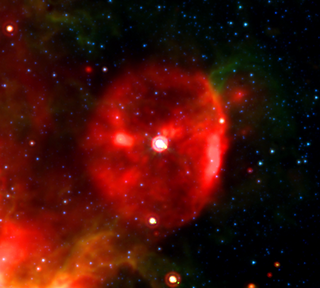
HDE 316285 is a blue supergiant star in the constellation Sagittarius. It is a candidate luminous blue variable and lies about 6,000 light years away in the direction of the Galactic Center.

BC Cygni is a red supergiant and pulsating variable star of spectral type M3.5Ia in the constellation Cygnus.

RW Cygni is a semiregular variable star in the constellation Cygnus, about a degree east of 2nd magnitude γ Cygni. Its apparent magnitude varies between 8.05 and 9.70 and its spectral type between M3 and M4.

BI Cygni(BI Cyg, IRC +40408, BD+36 4025) is a red supergiant in the constellation Cygnus. It is an irregular variable star with a maximum brightness of magnitude 8.4 and a minimum of magnitude 9.9. It is considered a member of the stellar Cygnus OB1 association, its distance is around 2,600 parsecs (8,500 ly) of the Solar System. It is less than a degree south of another variable red supergiant, BC Cygni.
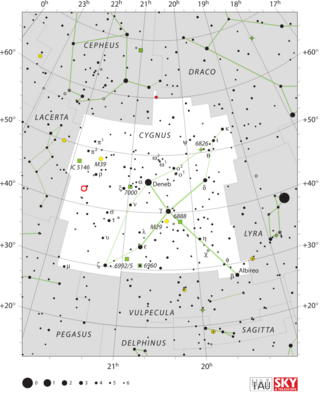
Q Cygni, is a star located in the constellation Cygnus. It is also known as Nova Cygni 1876, and has the designation NGC 7114, and HR 8296. Nova Cygni is located in the northwestern portion of Cygnus along the border with Lacerta.
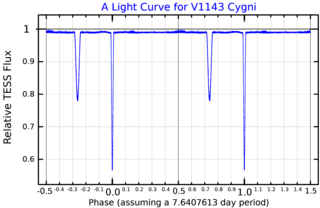
HR 7484 is a binary star system in the northern constellation of Cygnus. It is dimly visible to the naked eye under good viewing conditions, having an apparent visual magnitude of 5.89. Based upon an annual parallax shift of 24.71, it is located 132 light years away. The system is moving closer with a heliocentric radial velocity of −14 km/s.

V392 Persei, also known as Nova Persei 2018, is a bright nova in the constellation Perseus discovered on April 29, 2018. It was previously known as a dwarf nova.

CH Cygni is a red giant, variable, symbiotic binary in the constellation Cygnus. It is the nearest symbiotic star to Earth, and one of the brightest, making it an ideal candidate for study.

HV 888, also known as WOH S140, is a red supergiant (RSG) star located in the Large Magellanic Cloud. It is possibly among the largest known stars, with reliable estimates of its radius ranging from 1,353 R☉ to 1,584 R☉, and is also one of the most luminous of its type with a range of nearly 300,000 to over 500,000 times that of the Sun (L☉). The effective temperature is estimated to be around 3,500 K. If placed at the center of the Solar System, its photosphere would engulf the orbit of Jupiter.

Gliese 569 is a ternary star system composed of a main-sequence star orbited by a pair of brown dwarfs in the constellation of Boötes about 32 light years away.


